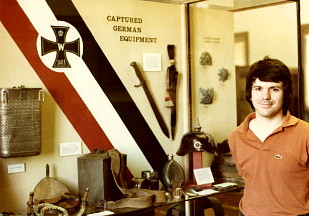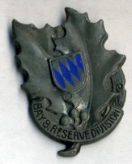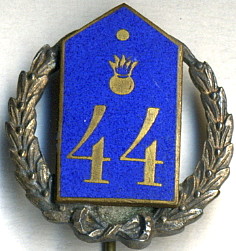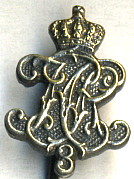-
Posts
2,962 -
Joined
-
Last visited
Content Type
Profiles
Forums
Blogs
Gallery
Events
Store
Posts posted by Chip
-
-
Chris,
The Bavarian M16 Bluse had a collar that was the same feldgrau wool as the rest of the tunic. Starting in October 1916 issued pieces had the Bavarian Kennzeichenborte completely around the low edge of the collar. By December of 1917 this braid was reduced to just a short strip on the front vertical part of the collar. By war's end, this braid was often missing altogether.
Regarding the removal of shoulder straps for raids, I would think it would be fairly easy for most officers had removable boards. The only straps that were routinely sewn into the shoulder seam, were Bavarian straps. You often see M1916 Bavarian straps with unfinish ends (not sewn shut acrosss the bottom edge), as they were just going to be hidden inside the seam anyway. I don't see how these straps could be easily removed and put back into place. All other post-1914 made enlisted straps were top stitched on, so they could easily be removed, but would have had to be reattached later. A little more work, but you do as you are told.
Other than the aforementioned Bavarian straps, you also encounter shoulder straps sewn into the shoulder seam on custom purchase tunics or issue tunics that have been altered due to a soldier being promoted. Often these "improved" issue tunics are set back for off duty wear and thus the removal of straps is not necessary.
Our national WWI museum in Kansas City has a mint condition field water carrier. It was part of the large cache of captured war material that was split amongst the states according to the percent of troops that it contributed to the war effort. The state was offered a large list to choose from. The stuff on it is amazing. Compared to what it could have taken, the state of Missouri took only a moderate amount of things.
The water carrier is painted feldgrau and has shoulder straps made from papercloth, so it can be carried on the back, like a pack. You can see it here in a display at the museum from 1978.
Chip
[attachmentid=35002]

 0
0 -
The last one is my favorite, a miniature version of the wartime bayr.8.Res.Div. cap/collar tinnie, which has been customized with the addition of the regimental information. I'm showing it beside the badge, once again, size is not relative.
Chip
[attachmentid=34909][attachmentid=34913]



 0
0 -
dond,
Sorry for the delay. I like these regimental pins too. There are more and more collectors bidding on them these days (I guess you can say that about any militaria!), so they are getting a bit pricey. I have had three of these for many years and the other three have come to me since the advent of ebay. Some are more common than others. You may well have seen examples of some of these, while others are quite scarce. The second from the left is the cypher of the 3.bayr.I.R., the same one that the regiment wore on their shoulder straps until 1916, when it was changed.
Sizes are not relative. I was experimenting. The J?ger pin is for the 5th J?ger Batl. The final piece consists of the regimental cypher of the 80th F?silier Rgt. superimposed over a starburst with Hessian lion in the center.
[attachmentid=34903][attachmentid=34904][attachmentid=34905][attachmentid=34906][attachmentid=34908]









 0
0 -
Glenn,
Thanks for posting the AKO. It's always nice to see the original document.
Chip
0 -
I suppose it is unlikely then, that these epaulettes date from the 1914-18 era.
Chip
0 -
Well, it would have to be 10.Grenadiers, but if epaulettes were subject to the same rules as shoulder boards, the line regiments wore the cypher and the reserve regiment wore an Arabic unit number.
Chip
0 -
Chris,
700 Euro sounds very expensive for something that isn't identified.

Chip
0 -
Rick,
I take it that the boards have Prussian Tresse? Also, can you remember from the information on the label, where the supplier was located?
Chip
0 -
Rick,
I like the personal history stuff too, but another thing that I find of particular interest is the little geometrical designs in the upper corners of this document. The 267.FAR as part of the 208th, so-called "Strich-Division", wore this design as a unit insignia on the left lower arm of their tunics. The triangle over a horizontal stripe, both in white cloth, were worn from the summer of 1917 on. Supposedly, these insignia were also painted on the back of their helmets as well. Here is a scarce photo of the insignia being worn by a soldier from the regiment (photo courtesy C.Wagner).
Chip

 0
0 -
Chris,
Any pictures coming?
Chip
0 -
You might get some clue from any maker information on the back, though often the manufacture of military buttons was farmed out to other countries. The eagle buttons are all Polish. The one on the bottom right looks similar to a French artilllery button, but this motif is pretty common for artillery, so it may well be Polish too.
Chip
0 -
While I agree that this cup is most likely from a later period, I don't see any definitive reason why it could not be from the WWI period. In my experience, these cups came with manufacturer's marks and dates, with manufacturer's marks and no date or with no markings at all. The rivets are a bit different, but that could easily be chalked off to manufacturer's peculiarities. As an example of existing peculiarities, most of these aluminum cups had pour spouts, but a fair amount of them (like Daniel's example) did not. We don't know why.
I have four marked aluminum cups. Three have dates (1910, 1911 and 1914) and the fourth is not maker marked, but does have a unit marking (104R.). I have yet to see what I could call a definite wartime dated example (that is, 1915 dated). They should exist, as the tinned steel version did not arrive until June of 1915. It is unclear what was being manufactured between the orders for the end of the use of aluminum in October of 1914 and the first Probe pieces of the tinned steel version, though I suspect the aluminum pieces had to be continued until the substitute was ready.
There was a canteen cup during WWI and it was found on the Labeflasche (Sanit?ter canteen), strapped to the top. The cups were originally made from aluminum, but were changed to tinned steel in the summer of 1915.
Chip
0 -
Mark's right. This is the cypher of the 2.bayr.I.R. The crown is very distinct and particular to this regiment. It is applied, that is, it is cut out and sewn down.
Chip
0 -
Chris,
That is a good price. I paid $38 for a pair in 1984!
Chip
0 -
Chris,
Mine are identical in materials (lighter gray overcoat colored wool on the outside and blue/gray wool on the inside), the only difference being that my pair does not have the separate trigger finger.
Chip
0 -
It looks extremely similar to the Bavarian Hartschiere NCOs shoulder board. Black velvet, silver button, lace and crown. The crown should be gilt, however, and the picture of the board in Das Deutsche Heer shows two edgings of lace, not one. Perhaps there was a lower rank?
Chip
0 -
Chris,
I have a nice pair and period photos too.

Chip
0 -
Joe,
It looks like your medal that is missing the bar would take regimental bar. I assume your medal says "Treu dem Regiment". I have two loose bars that I am looking for medals for, but neither is for a regiment. I need the "Treu dem Bataillon" medal. The other bar I have is for a company. I have never seen a "Treu dem Kompanie" medal. I don't suspect there were any made for units that small, but who knows. Afterall, they did make a company level bar.
Chip
0 -
Mike,
I think that generally speaking, the Sch?tzenabzeichen does fall into that category of insignia that are somewhere between a state and a Reich's award. All of the states (and the navy), with the exception of Bavaria, wore the black, white, red cord. The fact that the Saxons don't have a green/white cord and the W?rttembergers a red/black cord somewhat verifies this notion. The use of the same cord by the navy reinforces it as well.
Chip
0 -
Chuck,
These enameled Austro Hungarian badges are quite sought after, even the patriotic/civilian versions. I would guess that one with this much visual appeal and the Iron Cross motif would be worth somewhere in the range of $40-$50, perhaps more for the right buyer.
Chip
0 -
Paul,
That is definitely a Bavarian shield and if the cord is red/white/black, it is not Bavarian. Something is rotten in Denmark me thinks. Most of the cords are pictured in volume III of Das Deutsche Heer, plate 180. The major states had their own particular shield designs. The Bavarian design was like yours with the Bavarian Rautenshild and its inlaid color. The Prussian (and other states with the exception of Saxony and W?rttemberg) version had Wilhelm II's cypher as the central motif. So, there were five different shield possibilities. Silver Bavarian, gilt Bavarian, Saxon, W?rttemberg, and Prussian (et al.). Unfortunately, it seems that your cord was put together from two different examples, one Prussian and one Bavarian.
Chip
0 -
According to Das Deutsche Heer, there were ten degrees of the Sch?tzenabzeichen. This one, with a silver shield and silk (rather than wool) cord would be the sixth class. It is unclear in your picture, but it looks like the cord has red/white/black colors in it, whereas a Bavarian cord should have blue and white only. Is this one blue and white? If not, then the shield has been incorrectly added and that changes the degree and the value. If all correct, I would guess the value to be a much more conservative $175-$250, but these days no one really knows until one is offered for sale.
Chip
0 -
Brian,
Glenn identified your Heeresverwaltung boards correctly, but did not mention that they are from WWII era. Your other board with the the Kaiser crown would be for marine officers, not naval officers.
Chip
0 -
Rick,
Oooops! Get the hammer and chisel and chip that one out of the stone.

Chip
0




Any thoughts on these tabs and boards?
in Germany: Imperial Uniforms, Headwear, Insignia & Personal Equipment
Posted · Edited by Chip
Hello Dan,
The military official's boards are most likely from the Garnisonverwaltung (light blue underlay). The collar tabs match the description of the tabs for the Litewka, but I don't believe the tabs had pips during the imperial era, at least there is no picture or mention of pips in Kraus.
Chip